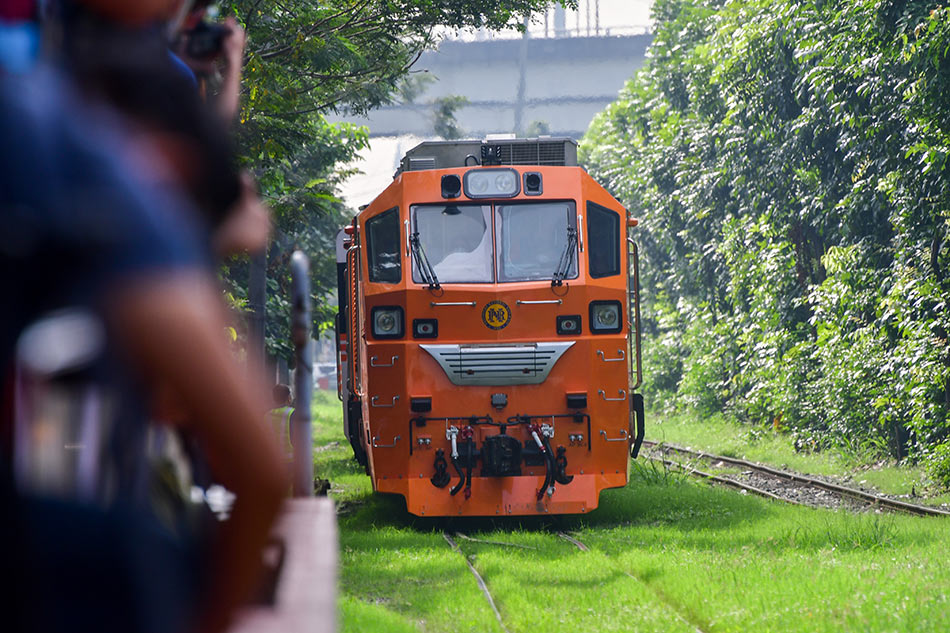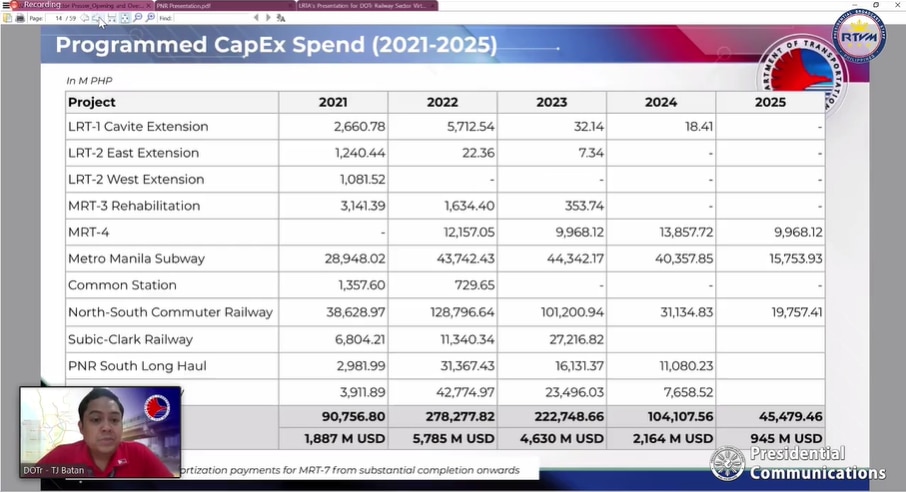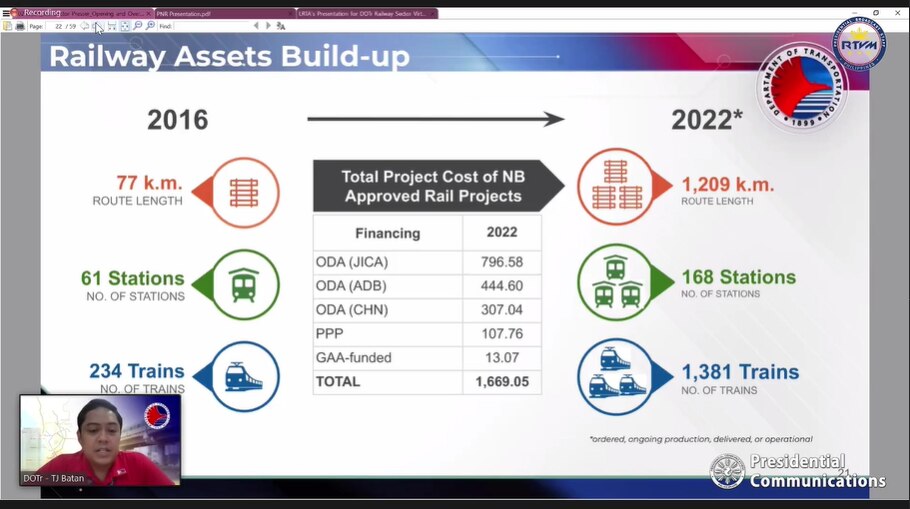P741 billion to be spent for Luzon, Mindanao railway projects from 2021 to 2025 - DOTr | ABS-CBN
ADVERTISEMENT

Welcome, Kapamilya! We use cookies to improve your browsing experience. Continuing to use this site means you agree to our use of cookies. Tell me more!
P741 billion to be spent for Luzon, Mindanao railway projects from 2021 to 2025 - DOTr
P741 billion to be spent for Luzon, Mindanao railway projects from 2021 to 2025 - DOTr
Nika Lazo,
ABS-CBN News
Published Feb 24, 2021 11:00 PM PHT
MANILA - A total of P741.4 billion in capital expenditures (capex) is being set aside for the development of multiple railway projects in Luzon and Mindanao, according to the Department of Transportation (DOTr) on Wednesday.
MANILA - A total of P741.4 billion in capital expenditures (capex) is being set aside for the development of multiple railway projects in Luzon and Mindanao, according to the Department of Transportation (DOTr) on Wednesday.
Timothy John Batan, the transport undersecretary for railways, said in a virtual presser that the government is allotting the budget for 11 railway projects to decongest Metro Manila and to move the country to progress.
Timothy John Batan, the transport undersecretary for railways, said in a virtual presser that the government is allotting the budget for 11 railway projects to decongest Metro Manila and to move the country to progress.
He cited that as of 2017, traffic congestion in Metro Manila has an annual economic cost of nearly P1.3 trillion.
He cited that as of 2017, traffic congestion in Metro Manila has an annual economic cost of nearly P1.3 trillion.
The capex spending program is expected to forward the country's major rail projects, which has a combined project cost of P1.669 trillion, broken down as follows:
The capex spending program is expected to forward the country's major rail projects, which has a combined project cost of P1.669 trillion, broken down as follows:
ADVERTISEMENT
- LRT-1 Cavite Extension - P65 billion
- LRT-2 East Extension - P9.5 billion
- LRT-2 West Extension - P10.1 billion
- MRT-3 Rehabilitation - P30 billion
- MRT-4 - P49.8 billion
- MRT-7 - P68.2 billion
- Metro Manila Subway - P357 billion
- Common Station - P2.95 billion
- North-South Commuter Railway - P777.6 billion
- Subic-Clark Railway - P50 billion
- PNR Bicol / South Long Haul - P175.3 billion
- Mindanao Railway - P81.7 billion
- LRT-1 Cavite Extension - P65 billion
- LRT-2 East Extension - P9.5 billion
- LRT-2 West Extension - P10.1 billion
- MRT-3 Rehabilitation - P30 billion
- MRT-4 - P49.8 billion
- MRT-7 - P68.2 billion
- Metro Manila Subway - P357 billion
- Common Station - P2.95 billion
- North-South Commuter Railway - P777.6 billion
- Subic-Clark Railway - P50 billion
- PNR Bicol / South Long Haul - P175.3 billion
- Mindanao Railway - P81.7 billion
Batan said the country's rail network is seen to expand to 1,209 km by 2025 from only 77 kilometers in 2016.
Batan said the country's rail network is seen to expand to 1,209 km by 2025 from only 77 kilometers in 2016.
This is comparable to the 170.2 km rail network of Jakarta, Seoul's 490 km, Tokyo's 700 km, and Shanghai's 690 km.
This is comparable to the 170.2 km rail network of Jakarta, Seoul's 490 km, Tokyo's 700 km, and Shanghai's 690 km.
Apart from the country's own budget, Batan said funding sources for the railway projects include official development assistance (ODA) loans from Japan International Cooperation Agency, Asian Development Bank, the Chinese government, and from the public-private partnership (PPP) scheme.
Apart from the country's own budget, Batan said funding sources for the railway projects include official development assistance (ODA) loans from Japan International Cooperation Agency, Asian Development Bank, the Chinese government, and from the public-private partnership (PPP) scheme.
"We really need mass public transport. And trains or railways are the most efficient form of mass public transport with the highest capacity. That is why we are pushing for the funding of these projects even through loans," Batan said.
"We really need mass public transport. And trains or railways are the most efficient form of mass public transport with the highest capacity. That is why we are pushing for the funding of these projects even through loans," Batan said.
He noted that the Philippines is a "lower middle income country" that can afford to avail of ODA loans with friendly rates.
He noted that the Philippines is a "lower middle income country" that can afford to avail of ODA loans with friendly rates.
ODA loans, he said, are offered to the Philippines for as low as 0.1 percent per annum, 40 years to pay, with 12 years grace period for payment.
ODA loans, he said, are offered to the Philippines for as low as 0.1 percent per annum, 40 years to pay, with 12 years grace period for payment.
Batan also reported that there were 32 contracts awarded last year for railway projects, and that they plan to increase this to 58 contracts this year, and 65 by next year.
Batan also reported that there were 32 contracts awarded last year for railway projects, and that they plan to increase this to 58 contracts this year, and 65 by next year.
The DOTr hopes the rail projects can decongest and replace thousands of cars and jeepneys, and hundreds of buses on the road.
The DOTr hopes the rail projects can decongest and replace thousands of cars and jeepneys, and hundreds of buses on the road.
RELATED VIDEO
ADVERTISEMENT
PSEi falls below 6,000 level anew
PSEi falls below 6,000 level anew
Jake Nataniel Dellosa
Published Feb 17, 2025 11:10 PM PHT
Watch more on iWantTFC.com. Watch hundreds of Pinoy shows, movies, live sports and news.
Watch more on iWantTFC.com. Watch hundreds of Pinoy shows, movies, live sports and news.
ADVERTISEMENT




